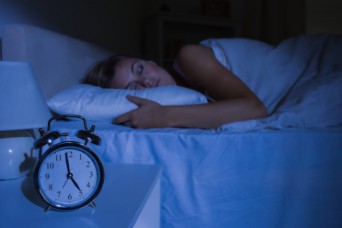Sleep disturbances are among the most common symptoms of fibromyalgia. In fact, along with fatigue, diffuse pain, and psychosocial distress, sleep disturbances are a core feature. In the last few years, it has become increasingly clear that treating the associated sleep disturbance improves the daytime symptoms of fibromyalgia. Here are eight things you need to know about sleep and fibromyalgia.
1. It is estimated that 2% to 10% of the population suffers from fibromyalgia.
2. 75% of those with fibromyalgia have sleep complaints. The most common is a feeling of non-refreshing or non-restorative sleep.
3. Insomnia, characterized by an inability to either fall asleep or stay asleep, is very common in fibromyalgia. Treating the insomnia with cognitive behavioral therapy and good sleep hygiene has been shown to improve symptoms of fibromyalgia.
4. People with fibromyalgia show less deep sleep, increased lighter stages of sleep, and more frequent arousals during the night than do others. Many of the newer medications approved for use in fibromyalgia such as pregabalin (Lyrica) work in part by increasing deep sleep.
5. In several studies of normal sleepers, disrupting deep sleep nightly for 7 to 14 days with either noise or awakenings resulted in symptoms indistinguishable from patients with fibromyalgia.
6. The incidence of Restless Legs Syndrome in fibromyalgia has been found to be in excess of 50% as opposed to 7% of the general population. The fibromyalgia patients experience improvement in their symptoms of fatigue and sleepiness when the RLS is treated.
7. In a 2013 study published in Clinical and Experimental Rheumatology, the incidence of sleep apnea in fibromyalgia was found to be 61% in men and 32% in women. A particular variant of sleep apnea called upper airway resistance syndrome is very common in women with fibromyalgia. Treating sleep-disordered breathing improves both pain and fatigue in fibromyalgia.
8. Sodium oxybate (Xyrem) is a drug used in narcolepsy that works in part by increasing deep sleep. I am often asked by patients with fibromyalgia if it is available to them. In 2010 the FDA rejected its use for fibromyalgia as being too risky. It is chemically very similar to the date rape drug GHB and they felt that the risks of wide dissemination outweighed the benefits.
In my practice I see many patients with fibromyalgia who come to me for their associated sleep disturbance. Whether it is insomnia, Restless Legs Syndrome, or sleep apnea, I can say that treating the associated sleep disturbance has a very positive effect on their fibromyalgia. My colleagues and I see an improvement in fatigue, cognitive function, and pain when the sleep disorder is addressed.


